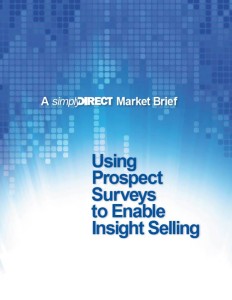 Situation: Your marketing/content team has developed an intriguing message which resonates with your B2B audience as insightful, differentiated, and relevant. You’ve produced content to nurture prospects along the various stages of their buyer’s journeys. Your case studies are rich with data, testimonials, and heartfelt stories of success. Now what?
Situation: Your marketing/content team has developed an intriguing message which resonates with your B2B audience as insightful, differentiated, and relevant. You’ve produced content to nurture prospects along the various stages of their buyer’s journeys. Your case studies are rich with data, testimonials, and heartfelt stories of success. Now what?
Challenge: As marketers, your challenge is to proactively help your sales team close deals. Can you create content that is more persuasive, compelling prospects into action? Can you tell a better story that sells, rather than merely informs?
Doug Kessler’s SlideShare presentation, Irresistible Content for Immovable Prospects[i] (recently featured in a Hubspot post), neatly addresses just this issue of creating content that sells. Following are 5 key aspects in crafting the change imperative story, culled from a combination of Kessler’s work and the best storytelling techniques.
- Upset the status quo – get your prospect thinking from your perspective“The first and most important job of content that sells is to convince your prospect that the world has changed in a real, undeniable, significant, and relevant way.”[ii]The single biggest barrier to change is when your prospect has a different understanding of the current reality. If the status quo is going swimmingly, there’s no imperative to change. Yet if something significant in the business context is changing, then organizations need to proactively adapt to position themselves advantageously. Change equals risk. To incite change, the perceived cost and “risk of inaction, [must be] greater than the risk of action.”
- Tell a compelling storyBegin your ‘change imperative’ story at an uncontroversial, obvious place of widespread agreement, but then unfold the story from your insightful perspective. Take care to clearly convey the “change event” that is disrupting the status quo. Inevitably, there will be some points in your story which stretch the understanding of your more conventional audience as they absorb this new-to-them perspective. Identify those most common gaps in understanding and carefully detail in your story the corresponding “aha moments” where prospects tend to shift from confusion to clarity.
- Address the critical ‘Why’ & ‘Why now’Create an urgency for your unique solution – not simply by answering the ‘why,’ but more importantly, the ‘why now’? Don’t merely explain what it is you offer, but focus first and primarily on why people use your solution and how they are leveraging it for greatest value. And always communicate the real cost of continued inaction. The key is to use your story to reset prospects’ buying criteria in your favor and trigger a purchase decision with compelling reasons as to why action is necessary right now.
- Keep it simple – focus on one story, problem, & resolutionBe direct and concise. Build the story logically and credibly, substantiated with just enough meaningful data to make it real, but not dry. Provide a clear resolution so prospects can easily grasp how to enact your solution and make it their own.
- Make it emotional, personal, visual, and memorableAs the award-winning screenwriter and director Robert McKee says, people aren’t inspired to act on reason alone – to really move and persuade them, your story has to “unite an idea with an emotion.”[iii] Aspirations, fears, attitudes, and values are all key aspects both motivating and mitigating prospects’ buying decisions. Engage prospects by connecting into a key value or motivator and its associated emotion to drive the effect you want to achieve in them (see our post, How to create the content buyers say they want to read).Use visual storytelling for a transformative experience – ideas are much more powerfully conveyed and remembered as pictures.
To learn more about meeting the change imperative challenge read our brief “Prospect Surveys Enable Insight Selling”.
[i] http://www.slideshare.net/dougkessler
[ii] Ibid
[iii] http://hbr.org/2003/06/storytelling-that-moves-people/ar

